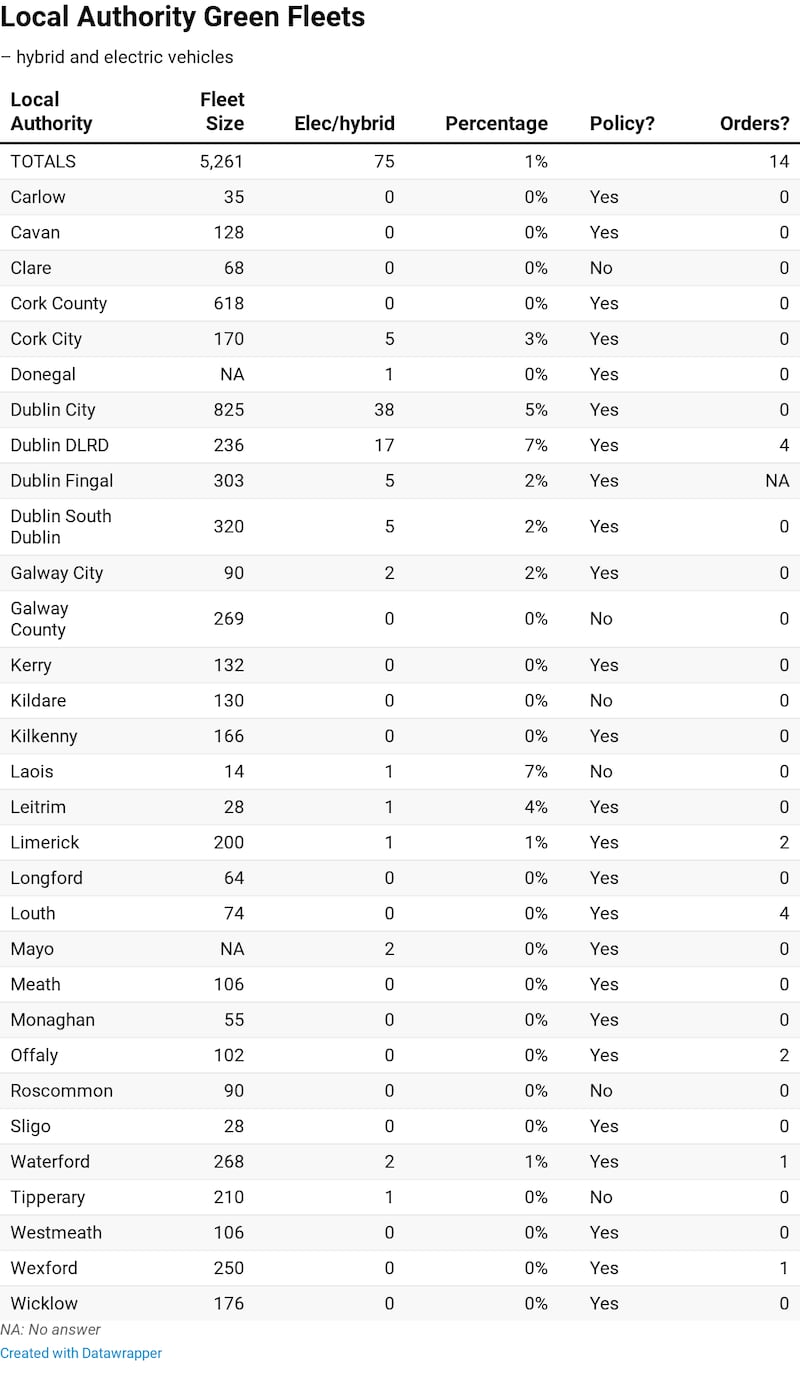Less than 2 per cent of local authority vehicles are electric or hybrid while no common policy exists on “greening” council fleets, data obtained from across the country shows.
While there is a growing awareness of a need for environmentally friendly alternatives, information garnered from county and city councils shows there is a long way to go before any meaningful change is made.
Of at least 5,260 vehicles used by local authorities - ranging from small vans to large trucks - just 81 have been identified as electric or hybrid, many of which are used for refuse collection. By the beginning of 2019, there were only 14 such low-emission vehicles on order.
Policy positions vary widely - the majority of councils are at least open to considering environmentally friendly alternatives while others have more specific plans.

A major obstacle to State financed fleets ditching fossil fuels is the lack of suitable alternatives. Even where an appetite exists, council officials have little feasible choice when it comes to heavy trucks, while in larger counties electric and hybrid technology is considered insufficient to cover extensive geographical boundaries.
However, as technology and charging infrastructure develops, replacing Ireland’s vehicles will be necessary in helping drive reform in environmental behaviour.
Climate action minister Richard Bruton has said the public sector must lead by example and the Office of Government Procurement is currently developing a strategy for the procurement of electric vehicles on behalf of all State bodies including local authorities.
“This strategy will look at how to increase take up of electric vehicles across the public sector as well as making the process of procuring them easier,” his Department said.
Local authorities currently assess their own needs and formulate individual policy. In response to a series of questions, 15 indicated they had actively researched environmentally friendly options and 11 that they would consider such options among future acquisitions. However, many local authorities either had no discernible policy or said outright they had no plans to use “green” vehicles.
Unsurprisingly, given the “range anxiety” around electric vehicles, urban councils have been leading the way.
Dublin City Council and Dun Laoghaire Rathdown County Council have purchased 38 and 17 low-emission vehicles respectively - equating to 4.6 and 7.2 per cent of their total fleets. Cork City, Fingal and South Dublin each have five. However, 18 local authorities have none.
Inspire change
Despite practical shortfalls with the technology, and the relatively minute size of local authority fleets as a proportion of overall vehicle numbers in the country, there is a view the public sector must help inspire change.

A briefing document produced by the Office of Government Procurement for the Low Emission Vehicle Task Force noted how the public sector could “play a role in promoting environmental measures throughout its spending”.
Separately, the Department of Transport said green public procurement policies “represent a valuable tool in demonstrating strong leadership, as well as normalising and supporting the uptake of low-emission vehicles”.
Under the European Clean Vehicles Directive public contracting authorities procuring road transport vehicles under 3.5 tonnes must take into account certain environmental impacts including energy consumption and emissions of both CO2 and nitrous oxide (NOx).
A public awareness campaign funded by the Department of Climate Action was at one stage supposed to include commercial fleet trials for the public sector. However, by the end of last January, the Department said its programme had not yet done so.
Dun Laoghaire Rathdown County Council has been among the leaders in driving local authority change.
In November, 2015, Marcella Murphy, former senior executive engineer in municipal services, was tasked with examining how best to renew its fleet and immediately began to look at green technology.
“The whole thing is changing. It would be terrible if the local authorities didn’t look around them and became dinosaurs,” she said.
Very quickly, however, Ms Murphy realised the limitations involved and focused entirely on car and van acquisitions. Today, the council has 17 vans and cars, has invested in charging infrastructure in depots and plans to continue replacing its stock. As well as reducing fuel consumption, they stand to dramatically improve on servicing costs.
The move, said Ms Murphy, has also proven popular with staff - electric vehicles can be utilised for everything from site inspections to housing maintenance and by on-call staff.
“It’s becoming more main-stream and I think it’s very important that county councils take a lead on that - to put it out there; to tell people this is what we are doing, that we believe in it.”
With technology quickly developing, others believe local authorities and other State bodies can move from adopting cars and vans to even heavier goods vehicles, particularly in the area of compressed natural gas (CNG) alternatives.
Green Party leader and vocal proponent of electric vehicles Eamon Ryan said he was approached recently by a dealer who told him there has been a significant increase in the availability of heavier electric trucks.
“It’s exploded and it’s a technology that has really taken off,” he said. “I think a lack of technology [will no longer be] a key restraint”.
Barriers to Green Fleets
However appealing the idea might be of “greening” State owned vehicle fleets, the reality is this very nascent technology has some way to go in terms of cost and performance.
Local authority drivers gritting long stretches of roads in rural Kerry are unlikely to savour the prospect of electric trucks with a fully charged range of 100 kilometres.
The procurement process can also be challenging, vehicles are expensive and often lack a hard-earned reputation for reliability.
A number of local authorities highlighted problems in evolving their fleets. Clare, Donegal and Kerry all mentioned the geographical nature of their counties as being incompatible with available technology.
Tipperary County Council said it wanted to see a battery range of about 250 kilometres to reach viability.
“The current battery range on electric 7.5 tonne pick-ups is approximately 80 to 90 kilometres,” it said. “This range would not be sufficient. It is very difficult to get prices and delivery dates from suppliers for electric 3.5 tonne vans and 7.5 tonne pick-ups at present, but the guide prices being quoted could be up to three times the cost of a diesel equivalent.” It also said the number of charging points is an issue.
Laois County Council said its €130,000 heavy trucks are unavailable in electric or hybrid versions and besides, "they are used so much on a daily basis there would be no time to recharge them".
Jarlath Sweeney, editor of Fleet Transport, said local authorities are beginning to look at environmental alternatives and switching to leasing models in order to afford them.
However, he explained, there are issues around driving licences. Currently, anyone with a regular car license can drive a vehicle weighing up to 3.5 tonnes. But because equivalent electric versions are heavier, this reduces their load capacity - an essential design aspect for local authority work. Efforts at European level to address this discrepancy are ongoing to bring total permissible weight to 4.25 tonnes.
In the meantime, technology is evolving quickly. Nissan, Renault, LDV and Iveco are all producing vehicles over 3.5 tonnes. Volvo has introduced electric trucks with maximum payloads of between 15 and 26 tonnes and a range of a 100 kilometres. MAN and Mercedes have developed similar electric trucks. However, such models are about twice the price of their traditional equivalents.
In time battery technology will no longer be an inhibitor to acquisition, but "time" is the operative word. "Outside of the main cities I can't see it happening any time soon," said Mr Sweeney.













